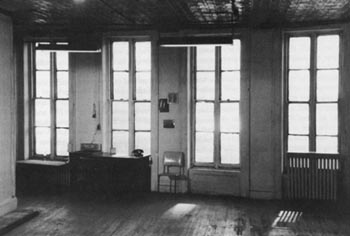![[MetroActive Movies]](http://metroactive.com/movies/gifs/movies468.gif)
[ Movies Index | San Francisco | MetroActive Central | Archives ]
What's Upfront
Michael Snow and Chantal Akerman sample New York at the SF Cinematheque
By Edward E. Crouse
Sit me in a room, tie me up and skip the gun. The question of the day is "What movie is the greatest murder mystery?" For sheer rigor and using the most seductive and efficient technique to tell its "story," Wavelength would easily take the honors.
Michael Snow's 1966 movie takes place in one room, through which the camera zooms for 45 minutes. Yeah, you heard me right, Jack. If you've never caught it, then here's its greatest virtue--it is one of the few movies people can remember shot for shot, and one of the few you'd want to. Reminding you where you are in relation to it (immobile, looking ahead, inactive except for your ear and eye and heart) and how, as in no other film since Rope, the camera is a ruthless and curious eye-substitute. What it shares with Rope is its status as a stunt. In the same way that Rope' has Hitchcock "fooling" the viewer into thinking the film is a feature-length traveling shot, Wavelength is often discussed, dissected and remembered falsely as a "one-shot" zoom.
When Wavelength first flares to life, two workmen are putting up a bookshelf, one asking an overcoat-clad lady, "How's that?" Then all three exit. Immediately, one is put in the position of waiting indefinitely for something to happen. For a few minutes there appears to be no this or that, no "important" matter for a viewer to absorb. But soon, the room begins to prevail, even as other humans flickeringly appear, then leave the frame, invading Snow's simple ecosystem like aliens. If this is starting to sound like a starchy, dry academic exercise, then a reminder should be issued that there is no drag or lag in the room's activity. The movie lacks nothing in terms of sheer kinetic energy, interest or humor. It even wields a pop score--"Strawberry Fields Forever"--a structural pun that could play on the movie's depth- of-field ploys. Everything about Wavelength--the relentless, loping thrust of the room shot, the changes in film stock, light quality, time of day--is frank, including its "story."
Wavelength prefigures electronica, trance-hop and ambient music, in that one's booty is now in one's eye, dancing across the screen, ravished with incremental shifts in texture and tone. The ear is hooked, too. Sounds are as carefully deployed as a sine wave, spending a lifetime getting from the bottom of the scale (a low-flying airplane hum) to the top (sonically resembling an Emergency Broadcast Test) until it dissipates. The outside world of storefronts and bus-truck traffic, wild elements that the director can't control, come across as samples through the distant four-windowed wall.
And the murder I mentioned? Soon a man wanders in and collapses, his body slumping toward the floor just at the bottom of the frame. Yet the zoom soon abandons him as a woman enters to call a friend to report the murder and to comment on the film: "He looks dead." Where the zoom finally ends is a mystery that I shouldn't spoil.
Though the likes of Taxi Driver, Serpico and Saturday Night Fever have sufficed to define the 1970s New York City landscape, another movie made at the same time--Chantal Akerman's News From Home--arguably lenses Gotham with more grit, formal elegance, verve and realism. A large part of its daring (as well as Wavelength's) derives from its abandonment of the star system, and in the absence of traditional actors these two films invest the screen with multiple choices, elements that a viewer can take or leave. Gone is the feeling of The Hustle, and replacing it is the chilling sense of distantly framed humans as mobile, dispensable elements in the visible world. Akerman's movie--a jaunty, long-take series of hyper-real, eye-level documentary shots--is a lush, candid accumulation of everyday people, played against a fragile soundtrack of monotonously read letters from her mother.
The SF Cinematheque, checking the millennial pulse of experimental film in an ambitious seven-part series they're calling "Conscious-ness Cinema," grouped these two essential works together in program six--an installment named "Conscious Spaces"--said in the program notes to "explore space and architecture through their existence in time." But when it comes to publicity, the Cinematheque can be a tad arid. I would have to side with John Waters, who proffers in his book Shock Value that underground/experimental and foreign films should exploit themselves and address prurient interest the way horror or nude movies used to. Even classier movies (e.g. Eyes Wide Shut) can't resist the temptation to capitalize on sex, intrigue and the promise of pornography--so why the hell should experimental movies hold back?
Forty-five minutes of flying through one room! Murder! Rip-roarin! See it now! Wavelength!
The best action movie of the 1970s! Big cars! Guilt! Torn from the streets of New York! News From Home! Run to it!.
[ San Francisco | MetroActive Central | Archives ]
Copyright © Metro Publishing Inc. Maintained by Boulevards New Media.
![]()

'Wavelength' and 'News From Home' screen with 'Paris and Athens,' June at 7:30 on Nov. 23 at Timken Lecture Hall, California College of Arts and Crafts, 1111 Eighth St. Admission is $5-$7. For more information, call 415.558.8129.
From the November 22, 1999 issue of the Metropolitan.